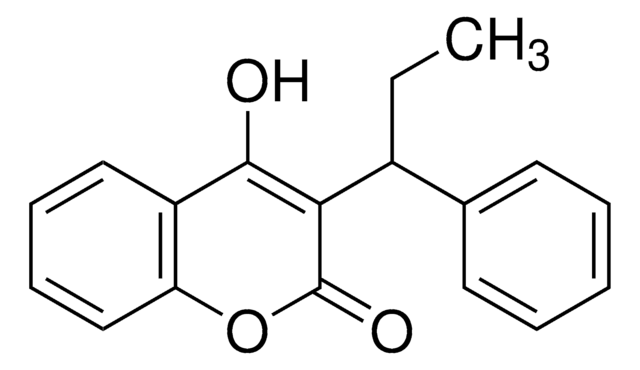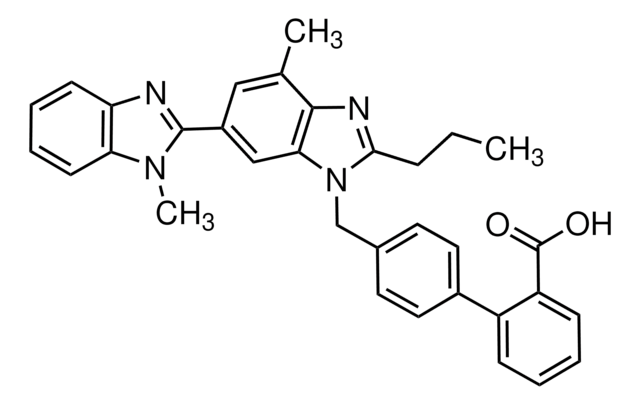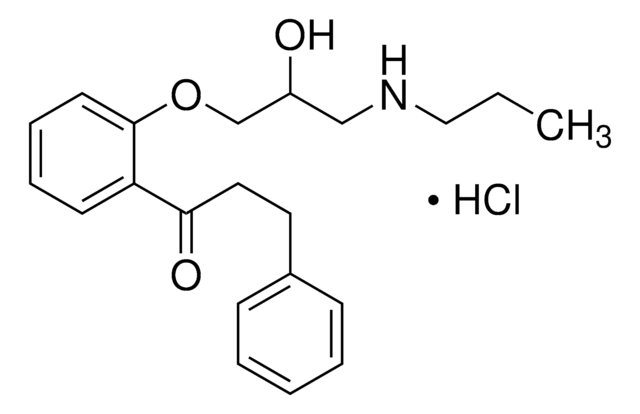P4670
Propafenone hydrochloride
Synonym(s):
1-[2-(2-Hydroxy-3-(propylamino)propoxy)phenyl]-3-phenyl-1-propanone hydrochloride
Sign Into View Organizational & Contract Pricing
All Photos(1)
About This Item
Empirical Formula (Hill Notation):
C21H27NO3 · HCl
CAS Number:
Molecular Weight:
377.90
EC Number:
MDL number:
UNSPSC Code:
41116107
PubChem Substance ID:
NACRES:
NA.77
Recommended Products
form
powder
Quality Level
originator
Abbott
storage temp.
2-8°C
SMILES string
Cl[H].CCCNCC(O)COc1ccccc1C(=O)CCc2ccccc2
InChI
1S/C21H27NO3.ClH/c1-2-14-22-15-18(23)16-25-21-11-7-6-10-19(21)20(24)13-12-17-8-4-3-5-9-17;/h3-11,18,22-23H,2,12-16H2,1H3;1H
InChI key
XWIHRGFIPXWGEF-UHFFFAOYSA-N
Gene Information
Looking for similar products? Visit Product Comparison Guide
General description
Propafenone hydrochloride is a calcium antagonist. It functions as a Na+ and K+ channel blocker. It might be used to treat patients with systemic hypertension. Propafenone hydrochloride is associated with bradycardia and bronchospasms. It is metabolized in the liver. Propafenone hydrochloride is used to treat ventricular arrhythmias.
Application
Propafenone hydrochloride has been used in the isolation of cardiomyocytes.
Biochem/physiol Actions
Blocks hKv1.5 and ATP-sensitive K+ channels; class 1C antiarrhythmic agent that is also an antagonist at β adrenergic receptors.
Features and Benefits
This compound was developed by Abbott. To browse the list of other pharma-developed compounds and Approved Drugs/Drug Candidates, click here.
Signal Word
Warning
Hazard Statements
Precautionary Statements
Hazard Classifications
Acute Tox. 4 Oral
Storage Class Code
11 - Combustible Solids
WGK
WGK 3
Choose from one of the most recent versions:
Already Own This Product?
Find documentation for the products that you have recently purchased in the Document Library.
Propafenone blocks ATP-sensitive K+ channels in rabbit atrial and ventricular cardiomyocytes
Christe G, et al.
European Journal of Pharmacology, 373(2-3), 223-232 (1999)
A Seki et al.
British journal of pharmacology, 126(5), 1153-1162 (1999-04-16)
1. The class Ic anti-arrhythmic agent, flecainide is known to inhibit the transient outward K current (Ito) selectively in human atrium. We studied the effects of propafenone, another class Ic antiarrhythmic agent, on K currents in human atrial myocytes using
Rate control vs rhythm control in patients with nonvalvular persistent atrial fibrillation: the results of the Polish How to Treat Chronic Atrial Fibrillation (HOT CAFE) Study
Opolski G, et al.
Chest, 126(2), 476-486 (2004)
The multiple modes of action of propafenone
Dukes ID and Williams EMV
European Heart Journal, 5(2), 115-125 (1984)
Pharmacologic management of arrhythmias
Ganjehei L, et al.
Texas Heart Institute Journal, 38(4), 344-344 (2011)
Our team of scientists has experience in all areas of research including Life Science, Material Science, Chemical Synthesis, Chromatography, Analytical and many others.
Contact Technical Service








